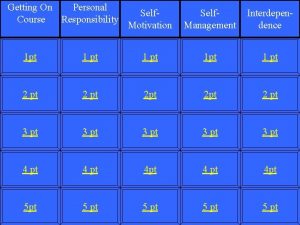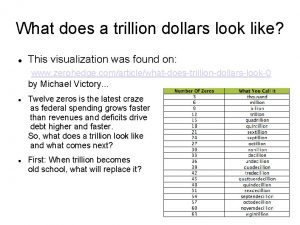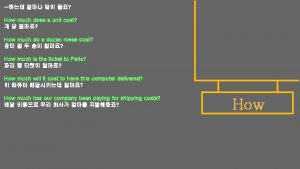How much does the U S spend to










- Slides: 10

How much does the U. S. spend to treat different diseases? Peterson-Kaiser Health System Tracker

Circulatory and ill-defined, such as check-ups, are the largest category of spending Total expenditures in $ billions by disease category, 2012 Ill-defined conditions $ 250 Circulatory $ 243 Musculoskeletal $ 188 $ 158 Respiratory Endocrine $ 139 Nervous system $ 134 Cancers and tumors $ 125 Injury and poisoning $ 119 Genitourinary $ 114 Digestive $ 108 Other $ 94 Mental illness $ 80 Infectious diseases $ 68 Dermatological $ 45 Pregnancy and childbirth $ 39 $- $ 50 $ 100 $ 150 $ 200 Source: Bureau of Economic Analysis Health Care Satellite Account (Blended Account) Note: Expenditures on nursing home and dental care not included in health services spending by disease. Peterson-Kaiser Health System Tracker $ 250 $ 300

The top 5 disease categories account for roughly half of spending Total expenditures in US $ billions by disease category, 2012 Pregnancy, birth; $39 Dermatological; $45 Infectious diseases; $68 Ill-defined conditions; $250 Other; $94 Mental Illness; $80 Digestive; $108 Circulatory, $243 Genitourinary; $114 Injury; $119 Musculoskeletal, $188 Respiratory, $158 Cancers; $125 system; $134 Endocrine; Source: Bureau of Economic Analysis Health Care Nervous Satellite Account (Blended Account) and$139 National Health Expenditure Data Note: Spending on dental services, nursing homes, and prescriptions that cannot be allocated to a specific disease not included above. Data last updated October 6, 2015. Peterson-Kaiser Health System Tracker

Spending grew fastest for ill-defined conditions and slowest for circulatory conditions from 2000 -2012 Per capita expenditures in US $ by disease category, 2000 - 2012 $850 $ 795 $750 Circulatory (high bp, heart attack, etc. ) $650 Ill-defined conditions (check-ups, post-op, etc. ) $550 Musculoskeletal (arthritis, back pain, etc. ) $450 $ 444 $350 Respiratory (pneumonia, asthma, etc. ) Endocrine (diabetes, high cholesterol, etc. ) $250 Nervous System (Alzheimer's, MS, epilepsy, etc. ) $150 Cancers and tumors $50 2001 2002 2003 2004 2005 2006 2007 2008 2009 2010 2011 2012 Source: Bureau of Economic Analysis Health Care Satellite Account (Blended Account) Note: Expenditures on nursing home and dental care not included in health services spending by disease. Data last updated October 6, 2015. Peterson-Kaiser Health System Tracker

About a third of medical services cost growth was from ill-defined, musculoskeletal, and circulatory conditions Contribution to medical services expenditure growth, by disease, 2012 16. 6% Ill-defined conditions Musculoskeletal 11. 0% Circulatory 8. 7% Endocrine 8. 5% Nervous system 7. 4% Respiratory 6. 6% Cancer 6. 3% Genitourinary 5. 9% Injury and poisoning 5. 4% Digestive 5. 1% Infectious diseases 4. 4% Mental illness 4. 1% Dermatological 2. 3% Pregnancy/childbirth 1. 7% Other 6. 2% 0% 2% 4% 6% 8% 10% 12% 14% 16% Source: Kaiser Family Foundation analysis of Bureau of Economic Analysis Health Care Satellite Account (Blended Account) Note: Expenditures on nursing home and dental care not included in health services spending by disease. Data last updated October 6, 2015. Peterson-Kaiser Health System Tracker 18%

Among major disease categories, the cost per case grew fastest for infectious diseases Average annual growth in price index by disease category, 2000 - 2012 Infectious diseases 6. 1% Nervous system 5. 3% Ill-defined conditions 5. 0% Digestive 4. 9% Injury and poisoning 4. 8% Musculoskeletal 4. 7% Dermatological 4. 7% Cancers and tumors 4. 6% Average for all diseases 4. 4% Genitourinary 4. 3% Respiratory 4. 2% Pregnancy and childbirth 4. 1% Endocrine 3. 6% Mental illness 3. 1% Circulatory 2. 7% Other 7. 2% 0% 1% 2% 3% 4% 5% 6% 7% Source: Kaiser Family Foundation Analysis of Bureau of Economic Analysis Health Care Satellite Account (Blended Account) Note: Expenditures on nursing home and dental care not included in health services spending by disease. Data last updated October 6, 2015. Peterson-Kaiser Health System Tracker 8%

The number of treated cases grew fastest for endocrine disorders and ill-defined conditions Average annual increase in real expenditures by disease category, 2000 - 2012 Ill-defined conditions 4. 4% Endocrine 4. 4% Infectious diseases 3. 0% 2. 9% Mental illness Musculoskeletal 2. 8% Average for all health 2. 0% Genitourinary 2. 0% Nervous system 1. 5% Cancers and tumors 1. 4% Dermatological 1. 4% Circulatory 1. 0% Pregnancy and childbirth 0. 9% Digestive 0. 6% Respiratory 0. 4% Injury and poisoning 0. 3% Other 2. 0% 0% 1% 1% 2% 2% 3% 3% 4% 4% 5% 5% Source: Kaiser Family Foundation analysis of the Bureau of Economic Analysis Health Care Satellite Account (Blended Account) Note: Expenditures on nursing home and dental care not included in health services spending by disease. Data last updated October 6, 2015. Peterson-Kaiser Health System Tracker

The cost per case has grown faster than the number of treated cases in most years since 2001 Percent change from previous year for price indexes and real expenditures on medical services by disease, 2001 - 2012 Cost per case 10% Number of treated cases 9% 8% 7% 6% 5% 4% 3% 3% 2% 2% 1% 0% 2001 2002 2003 2004 2005 2006 2007 2008 2009 2010 2011 2012 Source: Kaiser Family Foundation analysis of the Bureau of Economic Analysis Health Care Satellite Account (Blended Account) Note: Expenditures on nursing home and dental care not included in health services spending by disease. Data last updated October 6, 2015. Peterson-Kaiser Health System Tracker

Increases in prices and service intensity have driven most of spending growth Percent change from previous year for price indexes and real expenditures on medical services by disease, 2001 -2012 Number of treated cases Cost per case Source: Kaiser Family Foundation analysis of the Bureau of Economic Analysis Health Care Satellite Account (Blended Account) Note: Expenditures on nursing home and dental care not included in health services spending by disease. Peterson-Kaiser Health System Tracker

Major disease categories have mostly seen better outcomes along with higher spending Percent change in age standardized disability adjusted life years (DALYs) rate per 100, 000 population, both sexes, 2005 -2010 Percent change in medical services by disease spending per capita, 2005 -2010 Change in spending Improvement in disease burden 35% 30% 26% 25% 24% 21% 20% 15% 14% 12% 10% 7% 5% 0% All conditions Circulatory diseases Cancers and tumors Source: Kaiser Family Foundation analysis of data from the Institute for Health Metrics and Evaluation Global Burden of Disease Study 2010 (GBD 2010) and 2005, and BEA Health Care Satellite Account (Blended Account) Notes: Expenditures on nursing home and dental care not included in health services spending by disease. Peterson-Kaiser Health System Tracker
 Past simple, past continuous, past perfect
Past simple, past continuous, past perfect Red bull marketing budget
Red bull marketing budget How much time do you spend _______ tv every day?
How much time do you spend _______ tv every day? Creators spend as much time as possible in quadrant
Creators spend as much time as possible in quadrant How much
How much To whom much is given much is expected meaning
To whom much is given much is expected meaning How much is too much plagiarism
How much is too much plagiarism What does 1 million look like
What does 1 million look like Unequal distribution of water
Unequal distribution of water What does the world is too much with us mean
What does the world is too much with us mean How much does wanda earn per hour
How much does wanda earn per hour

















